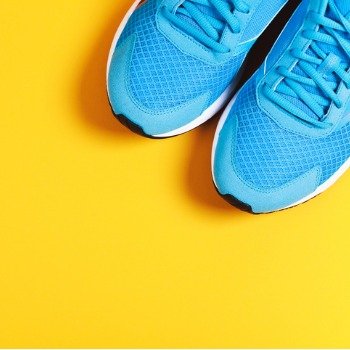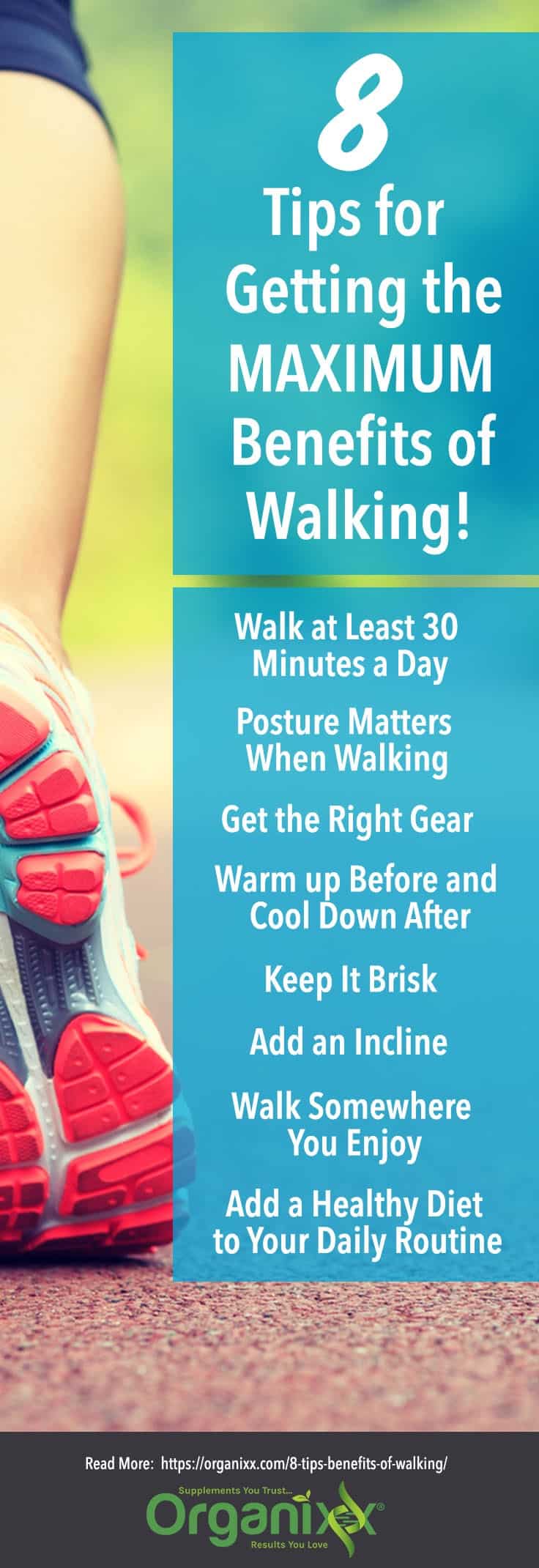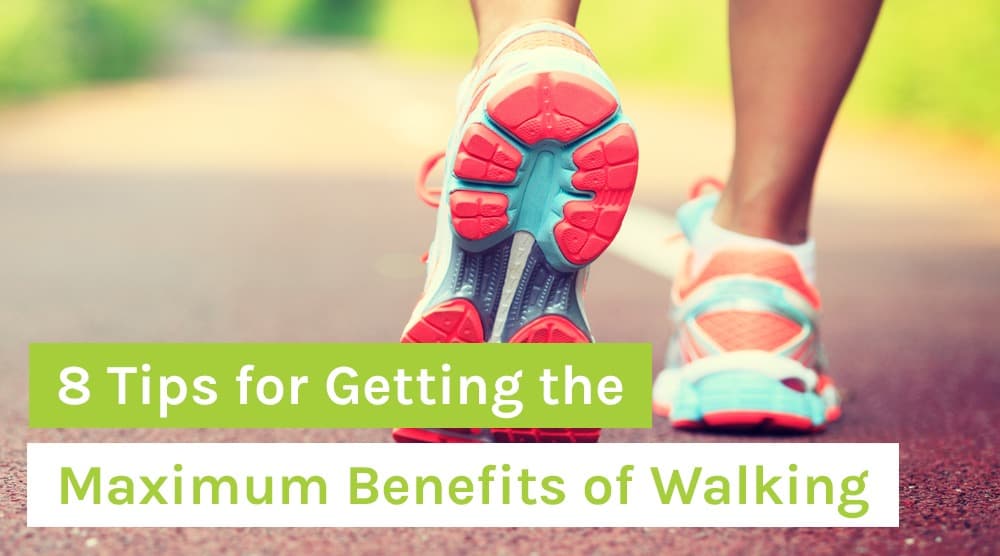8 Tips for Getting the Maximum Benefits of Walking
In a hurry? Click here to read the Article Summary...
Forget about running until you drop, swimming until you grow fins, or struggling to lift 100-pound weights. If you haven’t been exercising lately (or ever), then simple walking is an easy and inexpensive way to improve your health, start getting fit, and possibly drop a few unwanted pounds in the process.
If you’re already in pretty good shape, then walking is an excellent addition to your routine. If you have health concerns or are quite out of shape, be sure to get cleared by your healthcare provider before embarking on any new physical activity.
Experts say that the key to getting the most out of a walking routine is consistency. To ensure you’re getting all the benefits of walking possible, follow these eight easy tips:
#1. Walk at Least 30 Minutes a Day
The U.S. Centers for Disease Control and Prevention says that all you need to do is move your body 30 minutes a day, five days a week to lose weight and achieve better health [1].
A good strategy to make sure you stay consistent every day is to put your walking routine on your calendar just like any other appointment. Then treat it that way: don’t skip your appointment with good health!
#2. Posture Matters When Walking
According to the Mayo Clinic [2], to turn a stroll into a workout, you first need the right posture. Your posture for walking should be a gaze that faces forward (but doesn’t lean forward), relaxed neck, shoulders, and back, and arms that swing freely at your sides. Your steps should also go from heel to toe in a rolling motion.
For more of a workout, maintain a wider stride, pump your arms, and tighten your stomach muscles slightly as you move.
#3. Get Appropriate Walking Gear
 Make sure you have the right shoes! Appropriate gear is important to stay safe, says the Mayo Clinic. Tennis or walking shoes that have solid arch support, a firm heel, and flexible, thick soles are ideal. Most importantly, you’ll want to wear shoes that absorb shock.
Make sure you have the right shoes! Appropriate gear is important to stay safe, says the Mayo Clinic. Tennis or walking shoes that have solid arch support, a firm heel, and flexible, thick soles are ideal. Most importantly, you’ll want to wear shoes that absorb shock.
Bring a small, non-BPA water bottle for longer treks. If you’re in a hot climate, carry a walking stick for trekking on uneven terrain. It is also important to prepare for all kinds of weather.
Take a look outside and observe those rain or snow clouds before you head out. Then dress appropriately. For safety, if you are walking in the early morning or at night, be sure to wear a reflective vest or a brightly colored shirt for visibility.
#4. Warm up Before and Cool Down Afterwards
Warming up and cooling down is important for any kind of exercise [3]. Warming up helps get your cardiovascular system going and creates increased blood flow to your muscles. Cooling down afterward helps to bring your heart rate and blood pressure down slowly while avoiding muscle cramps.
For walking, be sure to warm up and cool down your legs, ankles, and feet. Aim for five minutes to warm up and cool down.

#5. Keep It Brisk
If you are new to exercising in general (or if it’s been a while), you may want to start slowly in the beginning and gradually increase both the speed and duration of your walk. Before too long, you should be going at a healthy clip that is about twice as fast as a stroll (about 3-4 miles per hour).
According to Dr. Andrew Weil, “(w)hile walking is indeed a gentle, safe exercise, it should not be effortless. To derive real benefit, you should be able to cover about three miles in forty-five minutes – a brisk pace. You should breathe more quickly and notice a slightly elevated heart rate, but still be able to easily carry on a conversation [4].”
#6. Add an Incline
Once you get on a roll with your walking routine, don’t be afraid to challenge yourself. Add stairs, a small hill, or even a mountain hike to your walk. Remember that by increasing your heart rate just a little bit, you will be reaping many benefits.
With your heart pumping more, you bring more nourishment and oxygen into your blood and muscles. You are also getting rid of carbon dioxide and increasing nitric oxide in the body [5]. Studies have shown that nitric oxide is a super anti-inflammatory [6] and can also boost the immune system and help prevent cancer [7].
#7. Walk Somewhere You Enjoy
Have you heard about the Japanese practice of “Shinrin-Yoku” [8]? In English, it is called “forest bathing.” Studies show that walking in nature, especially in forested areas, can boost immune function, lower cortisol levels, and even balance blood pressure.
When choosing where to walk, pick places surrounded by trees, by the sea, in a park, or other areas that you enjoy. Whenever possible, get out in nature. In addition to the benefits of walking, this will boost your health, improve your state of mind, and motivate you to keep walking.
#8. Add a Healthy Diet to Your Daily Routine
 Finally, don’t rely on walking (or any exercise routine) alone to reach your fitness and health goals.
Finally, don’t rely on walking (or any exercise routine) alone to reach your fitness and health goals.
According to a ground-breaking study conducted by researchers at The University of Texas M.D. Anderson Cancer Center, 95% of all cancers are preventable.
Of that number, 35% could have been avoided by dietary changes alone [9].
The only true way to live a vibrant life and have a tone, fit body is to eat a healthy diet of whole, live, organic foods, drink plenty of water, and move your body every day!
The Benefits of Walking Know No Bounds
Did you know that before the advent of modern life (and agriculture), some hunter-gatherer tribes used to walk an average of 26 miles a day? That is the equivalent of trekking from Los Angeles to New York and back every year. Not only were our ancestors getting a great workout, but they were also reaping all the other amazing benefits of physical exercise.
Walking Reduces Risk of Death!
A study of 8,000 men over 12 years published in the New England Journal of Medicine found that for those who regularly walked two miles a day, the risk of death dropped by about 50% [10]. The study also found that regular walking cut the risk of death from cancer by 65%.
Walking Improves Brain Function
Several studies have shown that walking can improve brain function, providing relief and calming of symptoms associated with Parkinson’s Disease [11].
A 2011 report published in the Proceedings of the National Academy of Sciences found that increasing exercise by walking reduced age-related shrinkage of the hippocampus in older individuals [12]. The hippocampus coordinates short-term memories and is the first part of the brain to be affected by Alzheimer’s disease.
No matter what your age, the proof that brisk walking is a valuable and scientifically validated form of exercise is out there.
Now it’s time for YOU have to get out there and start walking!
Organixx Clean Sourced Collagens blend contains five types of collagen from four sources. What’s more, it’s combined with targeted nutrients such as zinc, vitamin C, and vitamin B6 which specifically enhance the bioavailability and potency of collagen. Clean Sourced Collagens is formulated from the ground up to enhance and support your body’s natural ability to heal and rebuild itself from the INSIDE out.

 Sources:
Sources:
Article Summary
The key to getting the benefits of walking is consistency in your routine.
Moving your body 30 minutes a day can help you lose weight and achieve better health.
Warming up and cooling down is important for any kind of exercise.
Walking in nature can boost immune function, lower cortisol levels, and balance blood pressure.
Over 33% of all cancers could have been avoided with dietary changes.
One study showed that regular walking cut the risk of death from cancer by 65%.





Thanks to all of you who have shared these concerns; and best of luck in their solutions.
I’d like to walk but it’s difficult with Parkinson.
I do swim laps because that’s what I had done for the last 35 years, but that’s getting difficult too, my main problem is my legs don’t work anymore.
I’m hoping for a cure, but I don’t that will happen.
This disease really change my life!!
Thanks Johnathan for all you do to help others, and your weight loss and life style change has been an inspiration to many. Wow, you look great. When do we get to hear your testimony?
Hi Regina! Thanks for your kind words! We love sharing our stories and providing inspiration to help people feel empowered to take control of their health.